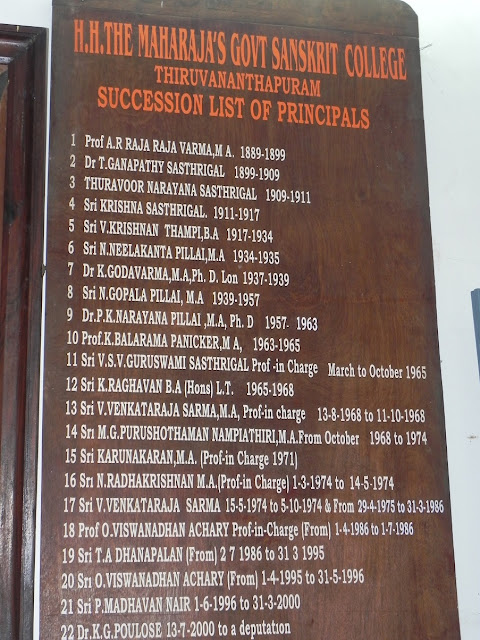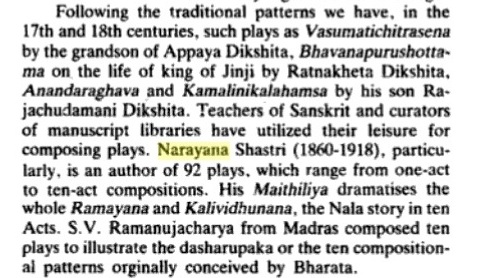Great boost from Shri D.K.M. Kartha to increase current knowledge about my great-grandfather, Sanskrit scholar Thuravoor Narayana Shastri
Last updated on 18th Apr. 2023
Copied with link update from ravisiyer.blogspot.com on 14 Apr. 2023, first published there on February 15, 2023
Around a week back, I received a pleasant surprise mail titled, "Thuravoor Narayana Sastri" (name of my great-grandfather Sanskrit scholar referred to later in this post as TNS) from Shri D.K.M. Kartha (Karthaji) where he wrote (and was OK with me sharing it publicly when I asked him later), "I am originally from Thuravoor and I remember hearing the name of your celebrated great grandfather in the 60's in one of my schools. He was perhaps the most illustrious son of my home village!"
I was delighted to know that Karthaji remembered hearing the name of my great grandfather as a celebrated person in the 60's (1960s) in one of his schools (in Thuravoor, I presume), and his view that TNS was perhaps the most illustrious son of Thuravoor. I thanked him profusely for the mail.
To know more about TNS please visit: List of my posts about my ancestor Thuravoor Narayana Shastri, noted Sanskrit Grammarian of late 1800s and early 1900s, based in Kerala, https://tnarayanasasthri.blogspot.com/p/list-of-my-posts-about-my-ancestor.html .
It is when I was digging up information about TNS in 2018 and later that I realized very directly, how time can cover up the life and work of a prominent scholar of the past, even 3 generations down the line. Last known activity of TNS seems to have been in 1910s or 1920s. So we are talking of slightly over a century back. Our family migrating from Kerala to Mumbai and elsewhere, and not being wealthy which forced the family to focus on earning livelihood, doubtless contributed to that memory getting more faded within the family. My key family source for that information was then the only living grandchild of TNS in our immediate family, which was my aunt - she passed away around a week back. But my aunt was able to only provide information from what she could recall. My cousins and my elder sister who are also grandchildren of TNS, were also able to provide some oral information from what they recollected of what their father/mother (and perhaps grandfather) had told them. Our family, especially my late uncle, grandson of TNS, may have preserved some records of TNS, but with the passing away of my late uncle (before I started digging up info. on TNS), that seems to have got lost.
Digging up info. from other sources like Govt. Sanskrit College, Thiruvananthapuram (Trivandrum), a distant cousin in Thuravoor and the Thuravoor Narasimhaswamy and Mahasudarsanamoorthy temple which with TNS would surely have been associated with during his days in Thuravoor and even later when he had moved to Thiruvananthapuram, did not provide significant information other than a picture of the list of principals board in the Govt. Sanskrit College with TNS name on it.
I give this context to explain why I am so happy to know of somebody originally from Thuravoor who remembers hearing the name of TNS in one of his schools in Thuravoor in the 1960s. I think Karthaji is the first person outside of the family of TNS, who I have had contact with, who remembers having heard his name during his schooling in Thuravoor!
Karthaji followed up on this initial mail exchange with a lot of suggestions on where I can make inquiries about TNS, which I plan to follow up in the near future. Then Karthaji himself dug up information on TNS and shared it with me! I am deeply grateful to Karthaji for the time and effort he has made to share these suggestions and dig up some information himself. As he knows Malayalam, he was able to provide me proper English translation of references to TNS in Malayalam books or articles. That has been of great benefit to me, as automatic Google translation of Malayalam to English sometimes is not accurate.
Given below is some of the information Karthaji dug up and shared with me on TNS, along with some comments of mine.
Note: Most of the year dates provided below are Kollam era year dates. From https://en.wikipedia.org/wiki/Malayalam_calendar : "The Malayalam Calendar is a sidereal solar calendar used in Kerala. The origin of the calendar has been dated to 825 CE, the beginning of the Kollam Era."
To convert Kollam era year to Common Era (CE) calendar year (which we use now), I could not get an easy-to-use website which works for any Kollam year. I think a rough conversion would be an addition of 825 to Kollam era year to get Common Era year. As an example from this post, K Sambashiva Shastri birth and death years (Kollam era) are given as 1054 and 1121. That, using our rough conversion, roughly should be 1879 and 1946 Common Era years. [https://www.prokerala.com/general/calendar/ provides a conversion facility via its "Change Date & Location" button/menu but only for the Kollam era years 1077 to 1201. It converts Kollam era year 1121 to CE year 1946 which matches our rough conversion (I don't recall which month I had selected but that would, at the maximum, change the year only by 1).]
1) കേരളം സാഹിത്യചരിത്രം -- ഭാഗം 5 (Kerala Sahitya Charitram) Kerala Literary History -- Part 5
മഹാകവി ഉള്ളൂർ Mahaakavi Ulloor (Ulloor S. Parameswara Iyer, https://en.wikipedia.org/wiki/Ulloor_S._Parameswara_Iyer )
[Ravi: Link of digital version (provided by Karthaji): http://ax.sayahna.org/ulloor/index.html . Note that "കേരളം സാഹിത്യചരിത്രം" is translated by Google as "Literary history of Kerala" and this free online Malayalam to Roman/Latin characters (used by English language) transliteration utility, https://nadh.in/code/ml2en/ transliterates "കേരളം സാഹിത്യചരിത്രം" to "Keralam saahithyacharithram". So this digital book seems to be the famous "Kerala Sahitya Charitram" book of Ulloor.
A 1953 edition of the book is available on archive.org. First volume link: Kerala Sahitya Charitram Vol 1 Ulloor 1953 ( KU), https://archive.org/details/kerala-sahitya-charitram-vol-1-ulloor-1953-ku/mode/2up . Other four volumes of the book and some other books of Ulloor can be accessed through this query link: https://archive.org/search?query=creator%3A%22Ulloor%22 .end-Ravi]
In a section within the book, we have the following text:
61.8 കെ. സാംബശിവശാസ്ത്രി (1054–1121). K Sambashiva Shastri
കുടുംബവും വിദ്യാഭ്യാസവും Family and Education
തിരുവനന്തപുരത്തു് ആയില്യംതിരുനാൾ മഹാരാജാവിന്റേയും വിശാഖംതിരുനാൾ മഹാരാജാവിന്റേയും ആശ്രിതനായി വൈക്കം കൃഷ്ണശാസ്ത്രി എന്നൊരു വ്യാകരണപണ്ഡിതൻ ജീവിച്ചിരുന്നു. ആ കൃഷ്ണശാസ്ത്രിയുടെ പുത്രനാണ് സാംബശിവശാസ്ത്രി. അച്ഛനു മകനെ ഇംഗ്ലീഷ് പഠിപ്പിച്ചാൽക്കൊള്ളാമെന്നു് ആഗ്രഹമുണ്ടായിരുന്നെങ്കിലും മകനു സംസ്കൃതപഠനത്തിലായിരുന്നു വാസന. പത്താമത്തെ വയസ്സിൽ പിതാവു മരിച്ചുപോകയാൽ നാലാം ഫാറത്തിൽവെച്ചു് ആ ദരിദ്രനായ ബാലനു് ഇംഗ്ലീഷു് വിദ്യാഭ്യാസം മതിയാക്കേണ്ടിവന്നു. അനന്തരം സംസ്കൃതമഹാപാഠശാലയിൽ പഠിച്ചു മഹോപാധ്യായ പരീക്ഷയിൽ വ്യാകരണവും സാഹിത്യവും ഐച്ഛികവിഷയമായി സ്വീകരിച്ചു് ഒന്നാമനായി ജയിച്ചു. അക്കാലത്തെ ഒരു മഹാവൈയാകരണനായ തുറവൂർ നാരായണശാസ്ത്രിയായിരുന്നു ഗുരുനാഥൻ.
Associated screenshot from https://tnarayanasasthri.blogspot.com/2023/04/few-significant-occurrences-of.html is given below (visit page to see higher resolution pic after opening image in new window).
[English translation provided by Karthaji of last two Malayalam sentences of text given earlier:]
Afterwards, Sambashiva Sastri studied at the Samskr^ta Mahaapaatthasaala and passed in the first class with Grammar and Literature as his Electives in the Mahopadhyaya Exam. His Gurunatha was the MahA-Vaiyaakarana of those times, Thuravoor Narayana Shastri.
[Ravi: In the above sentence I think "Samskr^ta Mahaapaatthasaala" is the Govt. Sanskrit College (or university) where TNS taught and was principal for some time. https://en.wikipedia.org/wiki/Mahamahopadhyaya informs us that "In ancient India, a scholar that wrote works based on topics related to the shastras was granted the title Mahopadhyaya". So Sri Sambashiva Sastri's Mahopadhyaya exam would have been for a higher education degree in Sanskrit.
Gurunatha in this context would mean Sanskrit teacher. https://www.wisdomlib.org/definition/vaiyakarana informs us that "Vaiyākaraṇa (वैयाकरण)" means]"[masculine] grammarian." "MahA-Vaiyaakarana", I think, means great grammarian. So in the above Malayalam text, Thuravoor Narayana Shastri is referred to as a great Sanskrit grammarian. end-Ravi]
An impressive list of KSS works can be seen at the following links:
- State Central Library Kerala, Online Catalog, http://103.251.43.202:8080/cgi-bin/koha/opac-search.pl?q=au:%22Sambasiva%20Sastri%20K.%22
- Amazon.com (online seller), https://www.amazon.com/Books-K-sambasiva-Sastri/s?rh=n%3A283155%2Cp_27%3AK+sambasiva+Sastri
- Exotic India (online seller), https://www.exoticindiaart.com/book-author/k%20sambasiva%20sastri/
It is very interesting to know about Shri K. Sambashiva Shastri (KSS), student of TNS becoming an accomplished author with many published books.
2) From same Kerala Sahitya Charitam book of Mahakavi Uloor: http://ax.sayahna.org/ulloor/ulloor-5-58.html under Part 5 -> A. R. Rajarajavarma Koithampuran (1038–1093)
ആലപ്പുഴവച്ചു തന്നെ അവിടത്തെ ആശ്രിതനായിക്കൂടി കാലാന്തരത്തിൽ മഹാവൈയാകരണനെന്ന ഖ്യാതി ദിഗന്തരങ്ങളിൽപ്പോലും വ്യാപിപ്പിച്ച നാരായണശാസ്ത്രികൾ യാവജ്ജീവം കഥാപുരുഷന്റെ ബഹിശ്ചരപ്രാണനായിരുന്നു.
Associated screenshot from https://tnarayanasasthri.blogspot.com/2023/04/few-significant-occurrences-of.html is given below (visit page to see higher resolution pic after opening image in new window).
Thuravoor Narayana Shastri had met A.R. Rajaraja Varma already in Alappuzha. He had become an ASRita of the Prince. Later he, (Thuravoor Narayana Shastri) gained fame even in distant lands as a MahaavaiyAkaraNa. Until his passing away, Thuravoor Narayana Shastri was A.R. Rajaraja Varma’s बहिश्चरप्राण — his own life spirit outside his body. (Thuravoor Narayana Shastri and A.R. Rajaraja Varma had one life breath and two bodies!)
3) Book name: BhAshA - KiratARjjuneeyam (KirAtARjjuneeyam MahAkAvyam of BhAravi in Malayalam Translation)
Author: K. Sambashiva Shastri (Chief VyAkaraNa PaNDita, Royal Sanskrit College, Trivandrum)
SV Press, Thiruvananthapuram, 1092 (Kollam Era)
[On PC desktop/laptop, to open pic in larger resolution (if available), right-click on pic followed by open link (NOT image) in new tab/window. In new tab/window you may have to click on pic to zoom in.]
[English translation provided by Karthaji of relevant Malayalam sentences in above pic:]
Opinion by AR Rajarajavarma
Thiruvananthapuram, 6/2/1092
"I have examined the work of Shri Sambashiva Shastri in a way suggested by the sthAleepulAka nyAyam (-- checking rice kernels here and there to ascertain whether the whole pot of rice is well cooked). I decided to follow the sthAleepulAka nyAya because of my deep trust in Shri Thuravoor Narayana Shastri who examined the work for its fidelity to the original in Sanskrit and my trust in Shri Ulloor Parameshvara Iyer who examined the work for its linguistic accuracy (in Malayalam). My decision was influenced also by paucity of time........
4) In a PhD thesis (Mahatma Gandhi Universiy, 1993 by A. Mohanakshan Nair) called Mahakavyas of Pandalam Kerala Varma: a study (പന്തളം കേരളവര്മ്മയുടെ മഹാകാവ്യങ്ങള് - ഒരു പഠനം ) in chapter 5, page 240, there is a direct reference to TNS:
[English Translation provided by Karthaji of relevant sentences in above pic:]
"In 1914, Pandalam Kerala Varma Thampuran became the Malayalam Pandit at the Trivandrum Government High School. He started to live in Kaithamukku (a block of Thriuvanthapuram). During this period, he joined with Ulloor (Mahaakavi Ulloor Parameshvara Iyer) and began to learn the higher texts of Vyaakarana Mahaabhaashyam of Patanjali and the higher textbooks of Alankaara Shastram (Rhetorics and Poetic Aesthetics) under the guidance of Thuravoor Narayana Sastri."
I (Ravi S. Iyer) repeat that I am deeply grateful to Shri D.K.M. Kartha for all the information and inspiration he has provided for this post.
[I thank ax.sayahna.org, Wikipedia, wisdomlib.org, keralasahityaakademi.org and shodhganga.inflibnet.ac.in, and have presumed that they will not have any objections to me sharing the above small extract(s) and screenshots from/of their websites on this post which is freely viewable by all, and does not have any financial profit motive whatsoever.]







Comments
Post a Comment